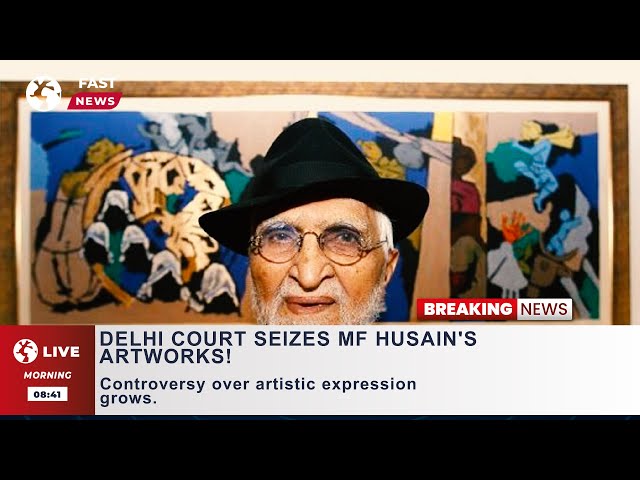
“Controversial Nude Depictions of Hindu Deities Confiscated from Indian Art Gallery”

**The M.F. Husain Controversy: Artistic Freedom vs. Religious Sentiment**
The ongoing debate surrounding artistic freedom and its intersection with cultural and religious sensitivities has once again surfaced in India. This time, the spotlight is on the late M.F. Husain, one of the nation’s most celebrated and controversial artists. Two of Husain’s drawings were seized from a solo exhibition titled *Husain: The Timeless Modernist* at the Delhi Art Gallery (DAG) following a legal complaint from a visitor alleging they were offensive to Hindu religious beliefs. The incident has reignited conversations about censorship and the role of art in challenging societal boundaries.
### **Genesis of the Controversy**
The two drawings in question, which were displayed at DAG’s New Delhi location in Connaught Place, depict Hindu deities—Ganesh and Hanuman—in a provocative manner. Ganesh is shown with a nude woman seated on his knee, while Hanuman appears nude, holding a woman in his hand. Both works faced criticism for allegedly distorting religious icons in ways deemed offensive.
The complaint was filed by Amita Sachdeva, an advocate affiliated with the Delhi High Court, who cited Clause 299 of the recently implemented Bharatiya Nyaya Sanhita (BNS)—India’s updated criminal code. The clause penalizes “malicious acts intended to outrage religious feelings.” Sachdeva went public with her concerns on social media and accused the gallery of removing the works before authorities initiated their investigation.
### **The Gallery’s Position**
In its defense, the Delhi Art Gallery released a statement affirming its commitment to artistic freedom and denying any wrongdoing. It emphasized its full cooperation with law enforcement, including the provision of security camera footage and other evidence related to the investigation. A spokesperson for the gallery characterized the complaint as being driven by a “religious agenda” and signaled the intent to defend itself vigorously in court.
“DAG strongly opposes the complainant’s unfounded allegations and shall call out her attempt to launch a malicious prosecution against [the gallery],” the spokesperson said. Furthermore, DAG hinted at pursuing its own legal remedies for what it described as false and motivated claims.
### **A Legacy of Controversy**
M.F. Husain was no stranger to controversies involving his depictions of Hindu mythology. Raised as a Muslim, Husain often infused his work with themes from various faiths, including Hinduism, reflecting his deep respect for India’s pluralistic cultural traditions. However, his portrayals of Hindu goddesses in nude or semi-nude forms—particularly a 1970s series—drew ire from Hindu nationalist groups. The backlash led to obscenity lawsuits, vandalism at his exhibitions, and even death threats. Husain eventually left India in 2006, living in self-imposed exile in Qatar and London until his death in 2011.
While Husain’s works commanded astronomical prices and earned him prestigious honors, including the Padma Bhushan and Padma Vibhushan, his artistic vision repeatedly clashed with social conservatism. This duality of reverence and rejection continues to define his legacy.
### **Legal and Cultural Implications**
The controversy over the two drawings has reopened discussions about India’s laws governing freedom of expression versus the protection of religious sentiments. Clause 299 of the BNS specifically addresses “deliberate and malicious acts” that insult religion, but critics argue that such provisions are susceptible to misuse.
The judge presiding over the current case permitted the seizure of the artworks but denied the complainant’s petition for a formal police investigation, citing a lack of evidence of a cognizable offense. This ruling offers a temporary reprieve but leaves the door open for further legal action by Sachdeva.
### **Artistic Freedom at a Crossroads**
At its core, the debate asks difficult questions: Should artists have the liberty to challenge and reinterpret cultural and religious symbols? Can such reinterpretations coexist with the sentiments of communities that view these symbols as sacred? Husain himself saw art as a medium for exploration and dialogue. However, critics argue that his works crossed a line, showing insensitivity to deeply held beliefs.
### **The Broader Cultural Context**
India, a nation celebrated for its artistic diversity, has long grappled with balancing its artistic heritage with religious pluralism. Cases like Husain’s highlight the inherent tensions in a multicultural society navigating modernity. For some, art serves as a tool for questioning and reframing traditions. For others, it is a sacred domain that should remain insulated from critique.
### **Conclusion**
The seizure of M.F. Husain’s artworks serves as a microcosm of the broader struggle between creative freedom and social conservatism, one that continues to shape India’s cultural and legal landscape. As legal proceedings unfold, the case underscores the need for nuanced discussions about the evolving place of art in a complex, diverse society. Whether Husain’s works will return to their gallery walls remains